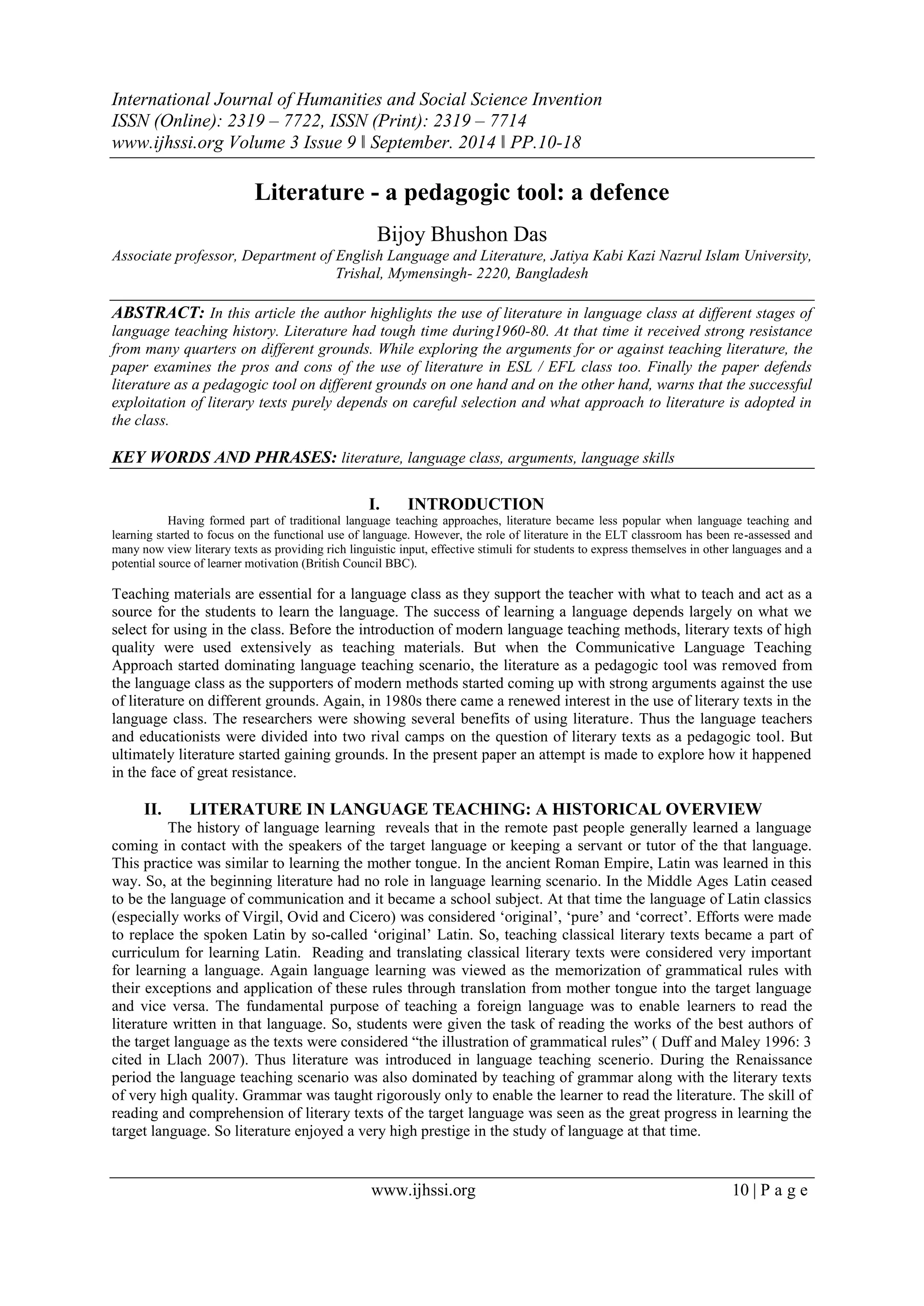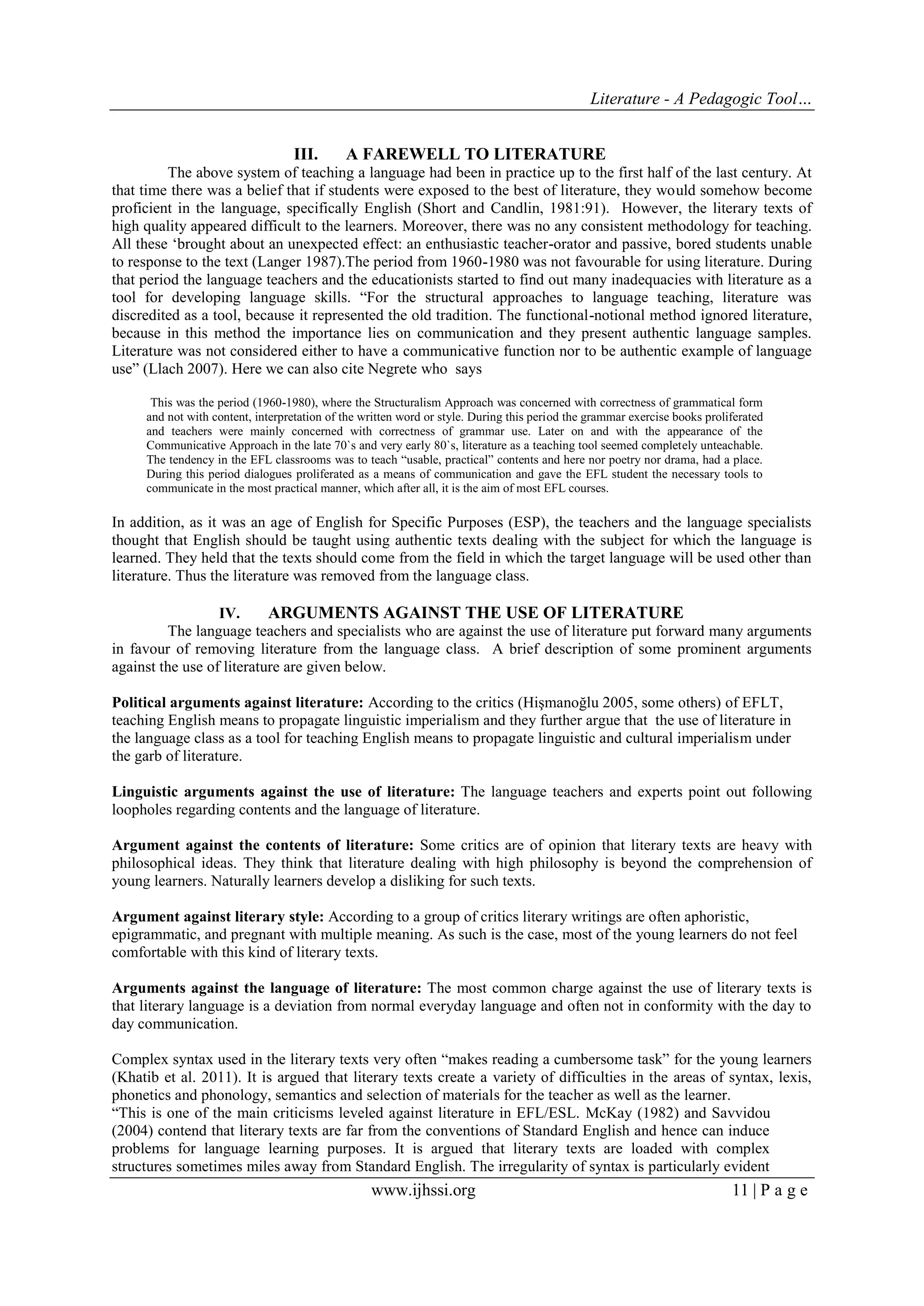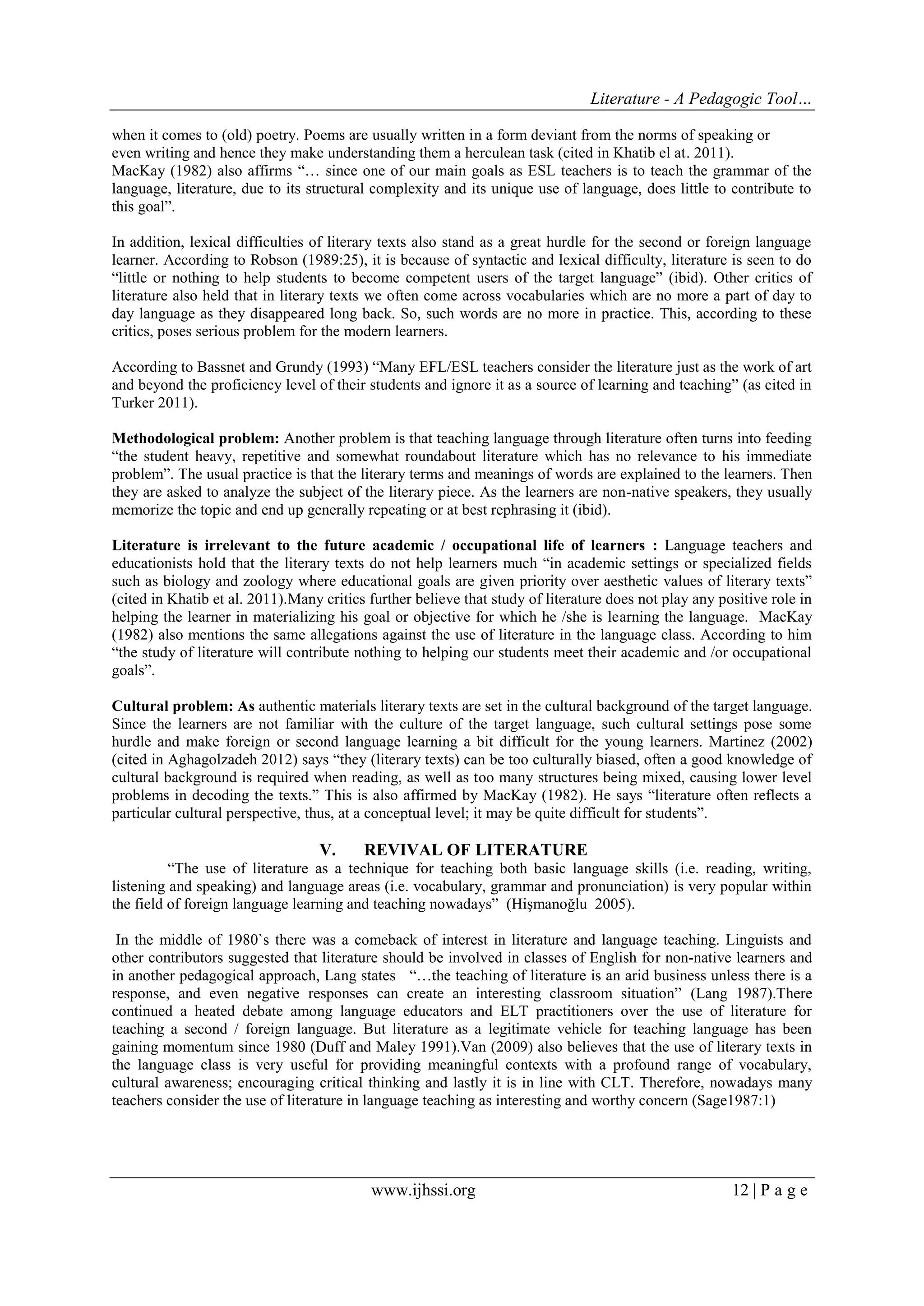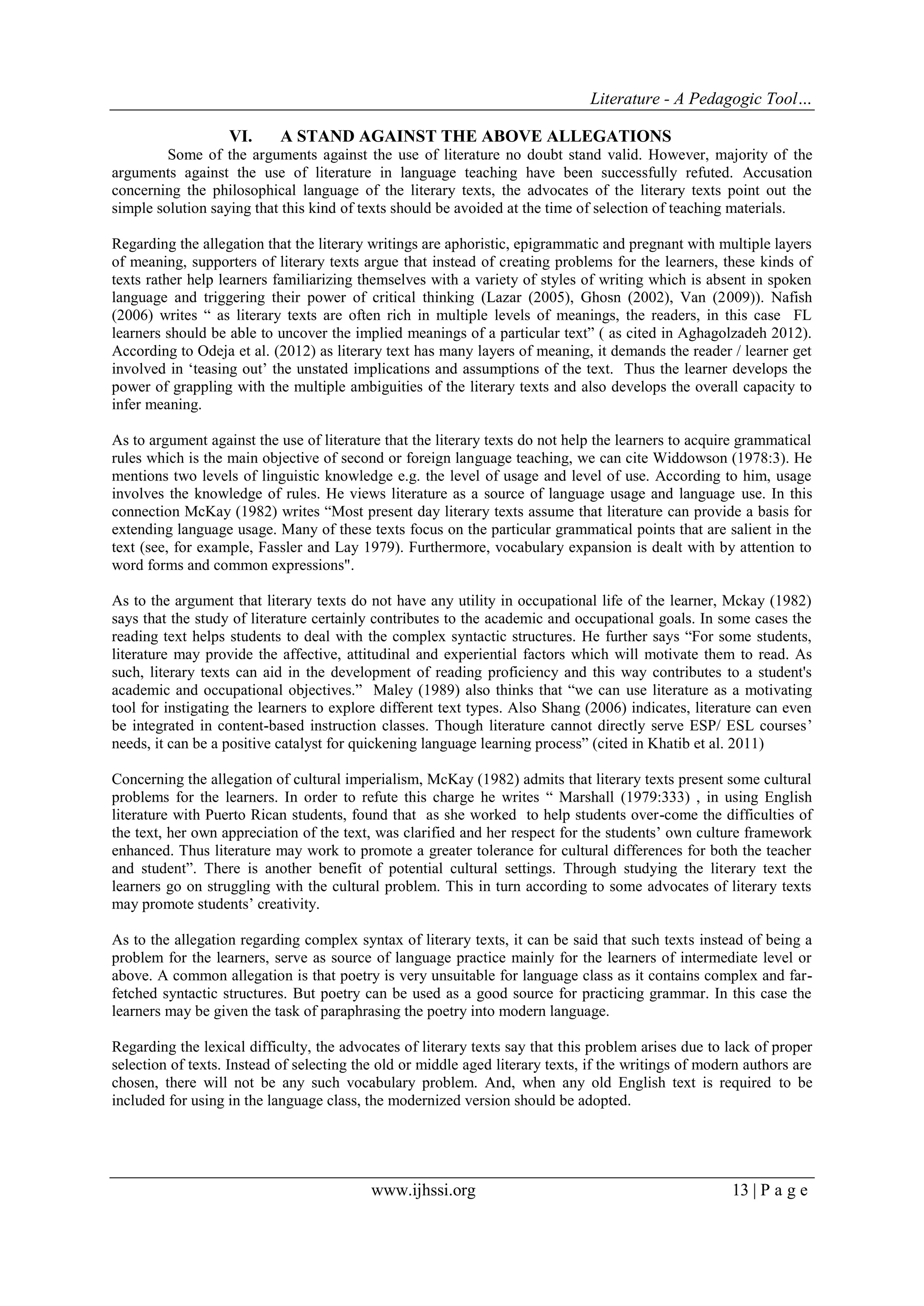The article discusses the historical and pedagogical role of literature in language teaching, highlighting its fluctuations in acceptance from the 1960s to the present. It examines both arguments for and against using literary texts in ESL/EFL classrooms, culminating in a defense of literature as a valuable teaching tool due to its potential for linguistic enrichment and learner motivation. The paper advocates for careful selection and appropriate approaches to effectively integrate literature into language learning curricula.




![Literature - A Pedagogic Tool…
www.ijhssi.org 14 | P a g e
As to the problem regarding semantic change of some words over time, it can be argued that “ …these semantic changes are not considered to block the learners‟ previous knowledge but an appendix to their earlier semantic repertoire. As long as they are not impeding language learning, no harm is expectant from these semantic variations” (Khatib et al. 2011).
Arguments for using of literature a pedagogic tool
In support of the use of literature in the language class, Povey (1972: 187) argues that “ literature will increase all language skills because literature will extend linguistic knowledge by giving evidence of extensive and subtle vocabulary usage , and complex and exact syntax” ( cited in McKay 1982). He further argues that the great advantage of using literature for developing language awareness among learners is that the language used in literature reflects a particular setting and a particular social setting needs particular register or special type of dialect. Maley (1989: 12) points out some of the reasons for regarding literature as a potent resource in the language classroom. They are as follows:
[1] Universality: Literature of all places deal with universal themes like human feelings, emotions e.g. hate, anger, love, marriage, separation, death, Nature etc. which appeal to human beings irrespective time, place and person.
[2] Non-triviality: Very often many language teaching inputs „tend to trivialize texts or experience. On the other hand literature never trivializes or underestimates a text. This is because literature „about things that mattered to the author when he wrote them‟.
[3] Personal Relevance: literature deals with what man has experienced and thought about life. So it generally “deals with ideas, things, sensations and events which either constitute part of the reader‟s experience or which they can enter into imaginatively, they are able to relate it to their own lives” (ibid:12).
[4] Variety: Literature includes all varieties of subjects within it. It is a great source of topics. “Within literature, we can find the language of law and of mountaineering, of medicine and of bull-fighting, of church sermons and nursery talk” (ibid: 12).
[5] Interest: One of the main functions of literature is to give pleasure to the reader as it deals with themes and topics which are intrinsically interesting. So it deals with only such kind of topics and human experience which definitely gives pleasures to the readers engaging their attention.
[6] Economy and Suggestive Power: “One of the great strengths of literature is its suggestive power. Even in its simplest forms, it invites us to go beyond what is said to what is implied. Since it suggests many ideas with few words, literature is ideal for generating language discussion. Maximum output can often be derived from minimum input” (ibid:12).
[7] Ambiguity: As the language of literature is highly associative and suggestive, it carries different meanings and messages for different readers. It is, therefore, very rare for two different readers to react identically to a given literary text. For language class, thus, literature has the following two advantages:
The first advantage is that each learner‟s interpretation has validity within limits. The second advantage is that an almost infinite fund of interactive discussion is guaranteed since each person‟s perception is different. That no two readers will have a completely convergent interpretation establishes the tension that is necessary for a genuine exchange of ideas” (ibid: 12). So we see that for teaching a second or foreign language the use of literature is a suitable tool for triggering interactive discussion in the class. Moreover, literature is storehouse of sociolinguistic richness as it provides students with a wide variety. Hismanoglu (2005) believes The use of language changes from one social group to another. Likewise, it changes from one geographical location to another. A person speaks differently in different social contexts like school, hospital, police station and theatre (i.e. formal, informal, casual, frozen, intimate styles speech). The language used changes from one profession to another (i.e. doctors, engineers, economists use different terminology). To put it differently, since literature provides students with a wide range of language varieties like sociolects, regional dialects, jargon, idiolects, etc., it develops their sociolinguistic competence in the target language. Hence, incorporating literature into a foreign language teaching program as a powerful source for reflecting the sociolinguistic aspects of the target language gains importance.](https://image.slidesharecdn.com/c0391010018-141021013432-conversion-gate02/75/C0391010018-5-2048.jpg)
![Literature - A Pedagogic Tool…
www.ijhssi.org 15 | P a g e
Literary texts are cultural documents that reflect different aspects of the society offering the opportunity for a deeper understanding of a country or countries (Basnet & Mounfold 1993). H.L.B. Moody also considers literature as an umbrella term giving information on every business (Moody 1971: 1 cited in Turker 2011). Collie and Slater (1991) also speak highly about the benefits of using literature in the language class. According to them Though the world of literature is created one, it depicts contextually vivid characters from varied social backgrounds. A reader can discover their thoughts, feelings, customs, possessions; what they buy, believe in, fear, enjoy, how they speak and behave behind closed doors. This vivid imagined world can quickly give the foreign reader a feel for the codes and preoccupations that structure a real society. Looking upon literature from linguistic point of view, Alexander Baird points out “Literature is the use of language effectively in suitable conditions” (ibid). Here Collie and Slater (1987) also voice that “ in reading literary texts students have also to cope with language intended for native speakers and thus they gain additional familiarity with many different linguistic uses, forms and conventions of the written mode: with irony, exposition, argument, narration, and so on”. According to Baird (1969) literary texts can be used in language teaching, because the language used in literary texts is suitable for the contexts of the events. “The role of literature in the ELT classroom has been re-assessed and many now view literary texts as providing rich linguistic input, effective stimuli for students to express themselves in other languages and a potential source of learner motivation” ( British Council BBC ). “ …the use of literature can also inspire students to take risks with the target language, enrich their vision, fostering critical thinking, stimulating their creativity and promote their greater cultural tolerance and sensibility” (Wen, Su 2010 cited by Fernandez). According to Odeja el al. (2012) it is true that the use of literature at lower level for linguistic purpose is not fruitful. But “at higher levels students may be so absorbed in the plot and characters of an authentic novel or short story that they acquire a great deal of new language almost in passing”. Other great advantage of literature is that literary texts can be used in its original form, or in its simplified or abridged version. “Another reasons for, or benefits of, teaching literature in the FL classroom have been proffered by a variety of authors. For example, Parkinson and Reid Thomas (2000: 9-11) list, with more or less approval, the following ten:
[1] Cultural enrichment. Reading literature promotes cultural understanding and awareness. (See also Collie and Slater 1987; Schewe 1998; Sell (ed.) 1995; Silberstein 1994).
[2] Linguistic model. Literature provides examples of “good” writing, linguistic diversity, expressive ranges, and so on.
[3] Mental training. Better than any other discipline, literature trains the mind and sensibility.
[4] Extension of linguistic competence. Literature stretches the competences of learners who have mastered the linguistic rudiments.
[5] Authenticity. Literature is genuine linguistic material, not a linguistically contrived textbook (Duff and Maley 1990).
[6] Memorability. Because literature, especially poetry and songs, is memorable, it can be a memorised archive of linguistic usage (Maley and Moulding 1985).
[7] Rhythmic resource. Poems assist the learner in assimilating the rhythms of a language (Maley and Moulding 1985).
[8] Motivating material. Literature is more likely to engage with and motivate a learner than artificial teaching inputs because it is generated by some genuine impulse on the part of the writer and deals with subjects and themes which may be of interest to the learner (Duff and Maley 1990).
[9] Open to interpretation. Because literature is open to interpretation, it can serve as a basis for “genuine interaction” between learners (Duff and Maley 1990).
[10] Convenience. Literature is a handy (photocopiable) resource” (cited in Sell 2005).
Lazar (1993:15-9) ( cited in Sell 2005 ) suggests that literature in the FL classroom motivates, offers access to cultural background, encourages language acquisition, expands language awareness, develops students‟ interpretative abilities and educates the whole person in so far as it enhances our imaginative and affective capacities (see also Fernández 2003: 60-31). “Burke and Brumfit (1986:171-2) state that literature promotes literacy and oracy, critical and analytical ability, social skills and the use of the imagination; encourages liberal, ethical and humanitarian attitudes, respect for the imagination, respect for literacy and cultural tradition; and provides information about literature, literary traditions and language” ( cited in Sell 2005). Hadaway, Vardell and Young (2002) point out the following advantages of using literary texts: i. Literature serves as an excellent source of contextualization of language. Through literary texts the learners become familiar with the variety of uses of language used in different situations.](https://image.slidesharecdn.com/c0391010018-141021013432-conversion-gate02/75/C0391010018-6-2048.jpg)
![Literature - A Pedagogic Tool…
www.ijhssi.org 16 | P a g e
ii. In literature different social and affective factors are set in. The literary texts such as picture books, news papers, short stories, etc. represent all sorts of social happenings and events in an impressive way. These can be exploited in the language for the benefits of students with individual differences. And as students differ with each other in respect of their likings and disliking, and tastes, different formats of literary texts can be used aptly in keeping with this. iii. “The third benefit refers to the natural and meaningful use of language which are accomplished by illustrations and use of descriptive language in literature” (Khatib 2011). Van (2009) (cited in Adegholdezah 2012) points out the following advantages of using literature in the language class:
[1] It provides meaningful context;
[2] It involves a profound range of vocabulary, dialogues and prose;
[3] It appeals to imagination and enhances creativity;
[4] It develops cultural awareness;
[5] It encourages critical thinking ;
[6] It is in line with CLT (Communicative Language Teaching) principles.
Literature is authentic texts as they are "real life texts, not written for pedagogic purposes" (Wallace 1992, Clandfield 2005). On the other hand, some researchers think that the modern EFL/ESL text books lack authenticity as they are fictions in different ways. "The artificial nature of the language and structures used, make them very unlike anything that the learner will encounter in the real world and very often they don't reflect how the language is really used"(cited in Aghagolzadeh 2012). So, undoubtedly the literary texts as authentic material is useful in language class because these texts show how language works in particular contexts demonstrating examples of particular type of language required for a specific situation. The literary texts, if properly used, can serve as a very powerful tool for developing all the language skills (listening, speaking, reading, and writing). “Literary texts offer a rich source of linguistic input and can help learners to practise the four skills - speaking, listening, reading and writing - in addition to exemplifying grammatical structures and presenting new vocabulary”(BBC). Scholars like Stern (1992), Belcher and Hirvela (2000), Van (2009) believe that literary texts can take care of these skills well ( cited Aghagolzadeh 2012).Through literature students learn about syntax and discourse, different structures, functions, and the different ways of connecting ideas, all these help students to develop their writing, listening, reading and speaking skills. Povey (1972) holds that literary texts are a good source for expanding learners‟ language skills. He thinks “literature will extend linguistic knowledge by giving evidence of extensive and subtle vocabulary usage, and complex and exact syntax” (cited in McKay 1982: 539). Scholars like Oster (1989), Murdoch (2002) Ghosn (2002), Cruz (2010) and other experts similarly hold a very positive view about the contribution of literary texts to developing all target language skills. In language learning, motivation plays a very effective role. If the learner is motivated, he/she can go a long way in learning the target language. Literary texts are a good source for motivating the learners as they are authentic and provide meaningful contexts. In this respect, Lazar (1993) says “It can help to stimulate the imagination of our students, to develop their critical abilities and to increase their emotional awareness” (cited in Negerete). Literature always deals with interesting things which usually appeal to our mind and as human beings we crave for such things in the world of our imagination. “Motivation is especially achieved when students are exposed to what they really enjoy. Experience shows that students are highly motivated when they are exposed to literary texts for language learning purpose” (cited in Khatib 2011). So the role of literature as a motivating tool cannot be denied.
VII. CONCLUSION
The above discussion reveals that there exists a debate among the educationists and language teachers regarding the use of literary texts as pedagogic tools. In 60s literature was removed from language classroom. This happened due to two reasons e.g. (i) absence of research on literature as a pedagogic tool and (ii) the traditional separation between the study of literature and the study of language. This is also voiced by Maley (2001) and Savvidou (2004). The former “argued that this attitude towards literature is due to a paucity of empirical research confirming the significance of literary input for language class” (cited in Aghagolezadeh 2012). And Savvidou (2004) “ believes that the reasons why few experts often consider literature inappropriate to the language classroom may be found in the common beliefs held about literature and literary language and these views reflect the historical separation between the study of language and the study of literature, which has led to the limited role of literature in the language class” (ibid).The above discussion reveals that well-chosen literary texts are very much conducive for teaching FL / SL though there exist some valid allegations against the use of them. When in 80s researchers started exploring literary texts as pedagogic tool for language class, a new](https://image.slidesharecdn.com/c0391010018-141021013432-conversion-gate02/75/C0391010018-7-2048.jpg)
![Literature - A Pedagogic Tool…
www.ijhssi.org 17 | P a g e
horizon was discovered. They came up with strong reasons showing multifarious benefits of using literature as teaching materials in language class. Consequently literature as pedagogic tool has come back today to the language class with flying colours. But while using literature in the language class, the language practitioners should bear in mind the following warning of Melania
If the approach to literature relies heavily on the teacher – who paraphrases, explains, clarifies the text, the students will become dependent on the ready-made commentaries and will probably see no use in reading the literary text itself. The danger of spoiling literature by over-teaching it appears in a language-based approach, too. If the analysis is undertaken in purely linguistic terms, with heavy emphasis on meta-language and little chance for personal interpretation, the students lose the best part of the literary text – its emotional value – and become demotivated. In light of the above discussion, the author of this article now firmly believes that the literature will yield immense benefits provided that the texts are interesting, having appropriate language level, not too long, culturally not offensive , not requiring “much cultural or literary background knowledge‟, and above all exploitable for language learning purposes ( British Council, BBC). REFERENCES
[1] Aghagolzadeh,F & Tajabadi,F (2012). A Debate on Literature as a Teaching Material in FLT Journal of Language Teaching and Research, Vol 3, No 1 (2012), 205-210 [2] Belcher, D. & Hirvela, A. (2000). Literature and L2 composition: revisiting the debate. Journal of Second Language Writing, 9, 21-39.
[3] Berardo, S.A. (2006). The use of authentic materials in the teaching of reading. The reading matrix 6. 2, 60-69.
[4] Bassnett, S., & Grundy, P. (1993). Language through literature. London: Longman.
[5] British Council, BBC. Teaching English Using Literature . http// www. Teachingenglish.org.uk, (accessed 05/03/2014).
[6] Brumfit, C. J. and Carter R. A. (eds.) (1986) Literature and Language Teaching. Oxford: Oxford University Press.
[7] Collie, J. and S. Slater. (1992). Literature in the Language Classroom: A Resource Book of
[8] Ideas and Activities. Cambridge: CUP.
[9] Cruz, J.H.R. (2010).The role of literature and culture in English language teaching.
[10] http://www.relinguistica.aza.uam.mx/no007/no07 art09.html (accessed 28/11/2013).
[11] DUFF, A. and A. MALEY. 1990. Literature. Oxford: Oxford University Press [12] Fernandez, A. LIGHT YOUR CLASS WITH A BIT OF LIT [13] http://www.apac.es/publications/documents/Light%2520up.doc (accessed 8/01/2014).
[14] Ghosn, I.K. (2002). Four good reasons to use literature in primary school ELT. ELT 56(2),172-179.
[15] Hadaway, N. (2002). Literature-based instruction with English language learners, K-12. Boston: Allyn and Bacon. http://www.paaljapan.org/resources/proceedings/PAAL9/pdf/Howard.pdf (accessed 3/6/2013).
[16] Maley, A. (1989b). A comeback for literature? Practical English Teacher, 10, 59
[17] Marshall, Madleine. 1979. Love and death in Eden: Teaching English literature to ESL students. TESOL Quarterly, 13, 3, 331- 340
[18] Murat Hişmanoğlu (2005). Teaching English Through Literature. Journal of Language and Linguistic Studies Vol.1, No.1, April 2005, 53-66
[19] Khatib, M., Rezaei, S., & Derakhshan, A. (2011). Literature in EFL/ESL classroom. ELT 4.1, 201- 208.
[20] Langer, J. (1997). Literacy acquisition through literature. Journal of Adolescent and Adult Literacy, 40, 602-614.
[21] Lazar, J. (2005). Literature and language teaching: A guide for teachers and trainers. Cambridge: Cambridge University Press.
[22] Llach,P.A. (2007). Teaching Language through Literature. Odisea 7-17 http://www.ual.es/Odesea08-Agustin,pdf (accessed 2/5/14).
[23] McKay, S. (1982). Literature in the ESL classroom. TESOL Quarterly 16.4, 529-526.
[24] Maley, A. (1989). Down from the pedestal: literature as resource. In R. Carter, R. Walker & C. Brumfit (eds.), Literature and the learner: methodological approaches. Modern English Publications and the British Counsel, 1-9.
[25] Moody,H.L.B.(1971). Teaching of Literature. Longman
[26] Nafisah, N. (2006). Literature in ELT setting: Paving the way for critical students. http//www.ebookbrowse.com/literature-in- ELT-setting-pdf-d124842092. (accessed 25/7/2013).
[27] Negerete,Y.E.D.C. Using Literature in the EFL Classroom. http:idiomas.ens.uabc.mxplurilinkgua/docs/v3/1/ArticleYalandaUsingEnpdf (accessed 22/09/13).
[28] Ojeda,B.P & Jover,M.T.(2012). Literature in the language classroom. http://www4.ujaen.es/~gluque/Literature (accessed 05/02/2014).
[29] Oster, J. (1989). Seeing with different eyes: Another view of literature in the ESL class. TESOL Quarterly 23.1, 85-103.
[30] Paduraru, M (2012). Literature in the language classroom. MIND THE GAP Melania Paduraru's Blog on Teaching English.http://mellaniep.wordpress.com/ (accessed 05/05/2014).
[31] Parkinson, B. & Reid Thomas, H. (2000). Teaching literature in a second language. Edinburgh: Edinburgh University Press.
[32] Povey, J. (1972). Literature in TESL programs: the language and the culture. In H. Allen & R. Campbel (eds.), Teaching English as a second language. New York: Mc.Graw Hill.
[33] Robson, A. E. (1989). The use of literature in ESL and culture-learning courses in US colleges. TESOL Newsletter,23, 25-27.
[34] Savvidou, C. (2004). An Integrated Approach to Teaching Literature in the EFL Classroom. The Internet TESL Journal 6.12. (accessed 25/05/2014).
[35] Sell, J. (2005). Why teach literature in the foreign language classroom? Encuentro15, 86-93.
[36] Short, M. H. & Candlin, C. N.( 1986). Teaching study skills for English literature. In C. J. Brumfit & R. A. Carter (Eds.), Literature and Language Teaching (pp. 89-109). Oxford:Oxford University Press.](https://image.slidesharecdn.com/c0391010018-141021013432-conversion-gate02/75/C0391010018-8-2048.jpg)
![Literature - A Pedagogic Tool…
www.ijhssi.org 18 | P a g e
[37] Sage, H.( 1987). Incorporating Literature in ESL Instruction. Oxford, Newjersey: Prentice -Hall.Inc
[38] Stern, S.L. (1991). An integrated approach to literature ESL/ EFL. In M. Celce- Murcia (ed.), Teaching English as a second or foreign language (2nd ed). New York: Newbury House, 328-346.
[39] Turker, F. (1991). Using literature in language teaching. Hacettepe Universitesi Egitim facultesi dergisi 6, 299-305. http://www.efdergi.hacettepe.edu.tr/19916FARUK TÜRKER.pdf (accessed 23/04/2014).
[40] Van, T.T.M. (2009). The relevance of literary analysis to teaching literature in the EFL classroom. English Teaching Forum 3: 2- 9.
[41] Wallace, C. (1992). Reading. New York: Oxford University Press.
[42] Wen Su, Shao. (2010). Motivating and Justifiable: Teaching Western Literature to EFL Students at a University of Science and Technology. TESL-EJ, 14.1.
[43] Widdowson (1982).The Use of Literature, Hines, Mary, and William Rutherford TESOL‟81 Washington D.C.](https://image.slidesharecdn.com/c0391010018-141021013432-conversion-gate02/75/C0391010018-9-2048.jpg)